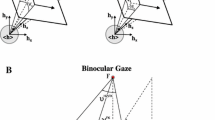Abstract
Two visual sensing modalities in insects, the ocelli and compound eyes, provide signals used for flight stabilization and navigation. In this article, a generalized model of the ocellar visual system is developed for a 3-D visual simulation environment based on behavioral, anatomical, and electrophysiological data from several species. A linear measurement model is estimated from Monte Carlo simulation in a cluttered urban environment relating state changes of the vehicle to the outputs of the ocellar model. A fully analog-printed circuit board sensor based on this model is designed and fabricated. Open-loop characterization of the sensor to visual stimuli induced by self motion is performed. Closed-loop stabilizing feedback of the sensor in combination with optic flow sensors is implemented onboard a quadrotor micro-air vehicle and its impulse response is characterized.















Similar content being viewed by others
References
Arning RK, Sassen S (2004) Flight control of micro aerial vehicles. In: AIAA guidance, navigation, and control conference and exhibit, pp 16–19
Chahl J, Mizutani A (2012) Biomimetic attitude and orientation sensors. IEEE Sens J 12(2):289–297
Chahl J, Thakoor S, Le Bouffant N, Stange G, Srinivasan MV, Hine B, Zornetzer S (2003) Bioinspired engineering of exploration systems: a horizon sensor/attitude reference system based on the dragonfly ocelli for mars exploration applications. J Robot Syst 20(1):35–42
Conroy J, Gremillion G, Ranganathan B, Humbert JS (2009) Implementation of wide-field integration of optic flow for autonomous quadrotor navigation. Auton Robot 27(3):189–198
Hengstenberg R (1991) Gaze control in the blowfly calliphora: a multisensory, two-stage integration process. Semin Neurosci 3(1):19–29
Hu KG, Reichert H, Stark WS (1978) Electrophysiological characterization of drosophila ocelli. J Comp Physiol 126(1):15–24
Humbert JS, Hyslop A, Chinn M (2007) Experimental validation of wide-field integration methods for autonomous navigation. In: IEEE/RSJ international conference on intelligent robots and systems, pp 2144–2149
Kerhuel L, Viollet S, Franceschini N (2010) Steering by gazing: an efficient biomimetic control strategy for visually guided micro aerial vehicles. IEEE Trans Robot 26(2):307–319
Kirschfeld K, Feiler R, Vogt K (1988) Evidence for a sensitizing pigment in the ocellar photoreceptors of the fly (musca, calliphora). J Comp Physiol A 163(4):421–423
Kordes T, Buschmann M, Winkler S, Schulz HW, Vorsmann P (2003) Progresses in the development of the fully autonomous mav carolo. In: 2nd AIAA unmanned unlimited systems, technologies, and operations aerospace
Krapp H, Wicklein M (2008) Central processing of visual information in insects. Senses Compr Ref 1:131–204
Krapp HG (2009) Ocelli. Curr Biol 19(11):R435–R437
Krapp HG, Hengstenberg R et al (1996) Estimation of self-motion by optic flow processing in single visual interneurons. Nature 384(6608):463–466
Laughlin SB, Parsons MM, Krapp HG (2010) Sensor fusion for feedback control of gaze stabilisation in the fly. Technical report, DTIC Document
Moore RJD, Thurrowgood S, Bland D, Soccol D, Srinivasan MV (2011) A fast and adaptive method for estimating uav attitude from the visual horizon. In: IEEE/RSJ international conference on intelligent robots and systems, IEEE, pp 4935–4940
Motazed B, Vos D, Drela M (1998) Aerodynamics and flight control design for hovering micro air vehicles. In: Proceedings of the 1998 American control conference, IEEE, vol 2, pp 681–683
Neumann TR, Bülthoff HH (2001) Insect inspired visual control of translatory flight. In: Advances in artificial life. Springer, pp 627–636
Neumann TR, Bülthoff HH (2002) Behavior-oriented vision for biomimetic flight control. In: Proceedings of the EPSRC/BBSRC international workshop on biologically inspired robotics, pp 196–203
Parsons MM, Krapp HG, Laughlin SB (2010) Sensor fusion in identified visual interneurons. Curr Biol 20(7):624–628
Schenato L, Wu WC, Sastry S (2004) Attitude control for a micromechanical flying insect via sensor output feedback. IEEE Trans Robot Autom 20(1):93–106
Schuppe H, Hengstenberg R (1993) Optical properties of the ocelli of calliphora erythrocephala and their role in the dorsal light response. J Comp Physiol A 173(2):143–149
Simmons P, Jian S, Rind F (1994) Characterisation of large second-order ocellar neurones of the blowfly calliphora erythrocephala. J Exp Biol 191(1):231–245
Srinivasan M, Zhang S, Lehrer M, Collett T (1996) Honeybee navigation en route to the goal: visual flight control and odometry. J Exp Biol 199(1):237–244
Srinivasan MV (1994) An image-interpolation technique for the computation of optic flow and egomotion. Biol Cybern 71(5):401–415
Stange G (1981) The ocellar component of flight equilibrium control in dragonflies. J Comp Physiol 141(3):335–347
Stange G, Stowe S, Chahl J, Massaro A (2002) Anisotropic imaging in the dragonfly median ocellus: a matched filter for horizon detection. J Comp Physiol A 188(6):455–467
Taylor GK, Krapp HG (2007) Sensory systems and flight stability: what do insects measure and why? Adv Insect Physiol 34:231–316
van Kleef J, Berry R, Stange G (2008) Directional selectivity in the simple eye of an insect. J Neurosci 28(11):2845–2855
Viollet S, Zeil J (2013) Feed-forward and visual feedback control of head roll orientation in wasps (polistes humilis, vespidae, hymenoptera). J Exp Biol 216(7):1280–1291
Wang W, Zhou Y, Wang F, Cheng Y, Song Y, Nonami K (2012) Attitude controller design for a small size multi-rotor mav. Inf Eng Lett 2(3):20–27
Wendel J, Meister O, Schlaile C, Trommer GF (2006) An integrated gps/mems-imu navigation system for an autonomous helicopter. Aerosp Sci Technol 10(6):527–533
Wilson M (1978) The functional organisation of locust ocelli. J Comp Physiol 124(4):297–316
Wu WC, Schenato L, Wood RJ, Fearing RS (2003) Biomimetic sensor suite for flight control of a micromechanical flying insect: design and experimental results. In: IEEE international conference on robotics and automation, IEEE, vol 1, pp 1146–1151
Acknowledgments
The authors would like to thank Hector Escobar Alvarez for his assistance with vehicle hardware integration.
Author information
Authors and Affiliations
Corresponding author
Additional information
This work was supported by AFOSR FA9550-09-1-0075.
Appendix
Appendix
Matrix of relative variance values, \(\sigma _\mathrm{rel}^2\), from (4):
Matrix of partial F-ratio values, \(F_n\), from (5):
Rights and permissions
About this article
Cite this article
Gremillion, G., Humbert, J.S. & Krapp, H.G. Bio-inspired modeling and implementation of the ocelli visual system of flying insects. Biol Cybern 108, 735–746 (2014). https://doi.org/10.1007/s00422-014-0610-x
Received:
Accepted:
Published:
Issue Date:
DOI: https://doi.org/10.1007/s00422-014-0610-x




